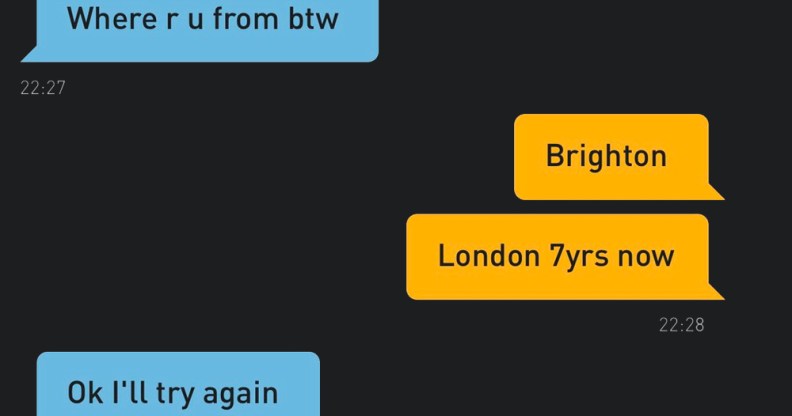Four words that sum up Grindr’s biggest problem

Grindr screenshot (Twitter/@Mufseen)
Grindr screenshot (Twitter/@Mufseen)
“Where are you from” may sound like an innocent question to ask on Grindr, but for queer people of colour (QPOC) it’s an exhausting, racist refrain.
Mufseen, a queer man of Asian descent, is one of countless men who’ve been asked the dreaded question.
After an unnamed man messaged him “where r u from btw,” he gave a simple, straight-forward reply: “Brighton… London 7yrs now.”
In response, the man wrote: “Ok I’ll try again… Where r ur parents from.”
When Reza replied: “I’m ethnically Bangladeshi,” the man ended the conversation with: “Ah ok.”
‘Ok I’ll try again’ ?#whereareyoufromfrom #grindr pic.twitter.com/KtgAUWpxMJ
— Mufseen ? (@mufseen) October 25, 2019
Screenshots of the conversation have been liked almost a thousand times on Twitter, presumably by the many queer people of colour who sadly find such an exchange thoroughly unremarkable.
Grindr and other LGBT+ dating apps have a race problem.
On Grindr and other dating apps, queer people of colour are routinely asked to quantify our ethnic origin, more often than not so that we can then be rejected on its basis.
“No fats, no femmes, no blacks, no Asians” is a popular choice of bio for a certain strain of white cis man for whom “it’s just a preference” is a hill they will die on. See also: “I prefer guys with blonde hair and blue eyes.”
It’s disappointing that this sort of behaviour is allowed to run unchecked on Beyoncé’s internet in 2019, but not surprising.
Queer people of colour face double discrimination.
Queer people of colour have historically faced double discrimination, both from their own ethnic group, on account of their sexual or gender identity, and from the LGBT+ community, on account of their race
Queer black and Asian people are half as likely to be accepted by their straight cis peers than white LGBT+ people.
The level of acceptance towards homosexuality among the general BAME population stands at 42 percent compared to 88 percent among white people, according to the most recent (2010) National Survey of Sexual Attitudes and Lifestyles.
On the other hand, just over half of all black, Asian and minority ethnic (BAME) queer people report experiencing discrimination within their local LGBT+ network because of their ethnicity, according to Stonewall.
Grindr and other dating apps appear to intensify the problem. When communication is done digitally and anonymously, racists are often emboldened.
Grindr tried to tackle the issue last year.
For its part, Grindr has acknowledged that it has a racism issue. In 2018 it launched its Kindr Grindr initiative, which gave QPOC a platform to discuss the issue and updated the app’s guidelines to clamp down on discrimination.
The app said that “anyone found bullying, threatening, or defaming another user will be banned.”
“We will also remove any discriminatory statements displayed on profiles,” it continued.
“You’re free to express your preferences, but we’d rather hear about what you’re into, not what you aren’t.
“Profile language that is used to openly discriminate against other users’ traits and characteristics will not be tolerated and will be subject to review by our moderation team.”
A year after the launch of Kindr Grindr, it’s difficult to see what impact the initiative has had.
The app’s makers did not respond to a request for a status update, and meanwhile Twitter continues to churn out stories like Mufseen’s.
How can we tackle this sort of discrimination?
In a 2018 report on racism within the LGBT+ community, Ruth Hunt, then-chief executive of Stonewall, said that a cross-community effort is needed.
“If real change for BAME LGBT people is to occur, we as a community need to hold a mirror to ourselves and have open conversations about how to change,” she wrote.
“This means learning to recognise our own privileges and to be active allies to each other.”
In practice, this means that white allies reporting profiles that shout “no chocolate, no curry” and having conversations with the people that hold such views. It also means educating young people not only about BAME history and LGBT+ identities, but about intersectionality.
Like almost every other LGBT+ issue, there is no single action or policy that can fix the issue, but rather a lengthy, thoughtful dialogue across the entire LGBT+ spectrum.

